Stevie Ray Vaughan: A Legacy in (South Texas) Blues Rock
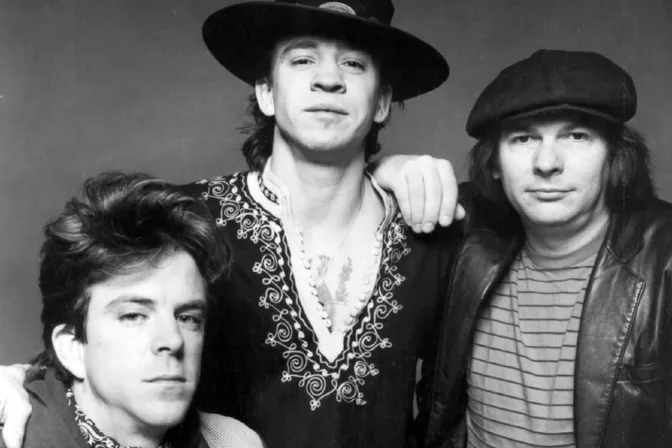 Photo Credit: By Don Hunstein - The photo was first published as a publicity photo. Original source: Scans of the original publicity photo can be seen at SRVArchive.com, Heritage Auctions (low-res but identifiable), WorthPoint, or Invaluable.com (high-res, signed by the artists). The latter scan can be found in the upload history below as additional verification of the lack of copyright notice. Instant source: Scan via Soundhound (retrieved March 14, 2021)., Public Domain
Photo Credit: By Don Hunstein - The photo was first published as a publicity photo. Original source: Scans of the original publicity photo can be seen at SRVArchive.com, Heritage Auctions (low-res but identifiable), WorthPoint, or Invaluable.com (high-res, signed by the artists). The latter scan can be found in the upload history below as additional verification of the lack of copyright notice. Instant source: Scan via Soundhound (retrieved March 14, 2021)., Public DomainStevie Ray Vaughan, often abbreviated as SRV, was a legendary American blues rock guitarist, singer, and songwriter. His incredible talent and passion for music left an indelible mark on the music industry. Let’s dive into the complete recording history of this guitar virtuoso.
Early Beginnings
Stevie Ray Vaughan began his professional career in the 1970s, playing in various bands around Austin, Texas. However, it wasn’t until the formation of Double Trouble that his recording career truly took off.
These albums not only chart the musical journey of Stevie Ray Vaughan but also tell the story of his personal struggles and triumphs. From the raw energy of his early recordings to the clarity and depth of his later work, Vaughan’s discography remains a cornerstone of modern blues and rock music.
Studio Albums with Double Trouble
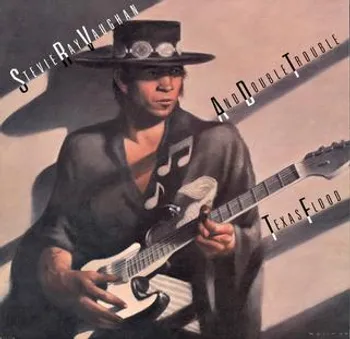
Texas Flood (1983)
- Recorded: November 22-24, 1982
- Location: Down Town Studios, Los Angeles, CA
- Equipment: Vaughan primarily used his “Number One” Fender Stratocaster and a Dumble Steel String Singer amp
- Technique: The album was recorded live in the studio with minimal overdubs
- Awards: Certified Platinum by RIAA; Grammy nomination for Best Traditional Blues Recording
“Texas Flood” was the debut studio album by Stevie Ray Vaughan and Double Trouble, and it immediately established Vaughan as a force to be reckoned with in the blues-rock world. The album’s creation was a serendipitous affair that perfectly captured the raw energy and talent of the young band.
Vaughan and Double Trouble were in Los Angeles, hoping to secure a record deal, when they were offered free studio time by Jackson Browne. The band recorded the entire album in just three days, capturing the live energy of their performances with minimal overdubs. This approach gave the album an authentic, immediate sound that resonated with listeners.
The album’s title track, “Texas Flood,” was a last-minute addition. Vaughan had heard Larry Davis’ version on the radio just days before recording and decided to include their rendition. This spontaneous decision resulted in one of SRV’s most iconic recordings.
Other standout tracks include the fiery instrumental “Rude Mood,” which showcased Vaughan’s lightning-fast guitar work, and “Pride and Joy,” which became one of his signature songs. The album also featured covers of Howlin’ Wolf’s “Tell Me” and The Isley Brothers’ “Testify,” demonstrating Vaughan’s ability to put his own spin on diverse material.
Despite the album’s eventual success, it was initially rejected by several major labels. Epic Records finally signed the band, largely due to the enthusiasm of legendary producer John Hammond Sr., who compared Vaughan’s talent to that of guitar legends like Jimi Hendrix and Charlie Christian.
“Texas Flood” reached number 38 on the Billboard 200 chart and eventually went double platinum. It received critical acclaim, with reviewers praising Vaughan’s guitar virtuosity and the band’s fresh take on traditional blues forms.
This album not only launched Stevie Ray Vaughan’s career but also played a significant role in revitalizing interest in blues-rock in the 1980s. “Texas Flood” remains a cornerstone of Vaughan’s discography and is widely regarded as one of the greatest blues debut albums of all time.
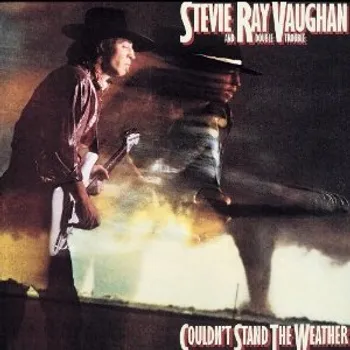
Album photo credit from Wikipedia licensed under Fair use
Couldn’t Stand the Weather (1984)
- Recorded: January 1984
- Location: The Power Station, New York City
- Equipment: Vaughan used his Fender Stratocasters and a Marshall 4140 100-watt amplifier
- Technique: More studio production compared to the debut album, with layered guitar tracks
- Awards: Certified Platinum by RIAA
“Couldn’t Stand the Weather” was Stevie Ray Vaughan and Double Trouble’s sophomore album, building on the success of their debut. For this effort, Vaughan and Double Trouble aimed to expand their sound, spending more time on arrangements and production.
The album’s recording process was more polished than their debut, reflecting the band’s growing confidence and musical ambition. It was recorded at the prestigious Power Station studio in New York, known for its exceptional sound quality.
One of the album’s highlights, the cover of Jimi Hendrix’s “Voodoo Child (Slight Return),” almost didn’t make the cut. Producer John Hammond Sr. initially opposed its inclusion, fearing comparisons to Hendrix. Vaughan insisted, and the track became a staple of his live shows and a showcase for his virtuosic guitar work.
The title track, “Couldn’t Stand the Weather,” demonstrated Vaughan’s evolving songwriting, featuring a complex arrangement and a mix of blues and rock elements. “Cold Shot” became one of Vaughan’s most recognizable hits, showcasing his ability to craft radio-friendly blues-rock.
The recording sessions weren’t without challenges. Vaughan’s escalating substance abuse issues sometimes affected his performance, leading to tension within the band. Despite these difficulties, the album showcased Vaughan’s growing confidence as a songwriter and his evolving guitar techniques.
“Couldn’t Stand the Weather” was a commercial success, reaching number 31 on the Billboard 200 chart and eventually achieving platinum status. It cemented Vaughan’s reputation as a rising star in the blues-rock world and expanded his audience beyond blues purists.
This album represents a crucial step in Stevie Ray Vaughan’s career, demonstrating his ability to build on his initial success while pushing his music in new directions. It remains a fan favorite and a high point in his discography.
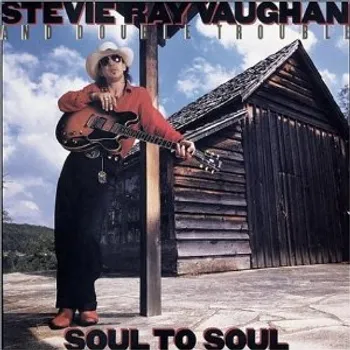
Soul to Soul (1985)
- Recorded: March-May 1985
- Location: Dallas Sound Lab, Dallas, TX
- Equipment: Expanded use of effects pedals, including an Ibanez Tube Screamer
- Technique: Incorporated more diverse musical styles, including soul and R&B influences
- Awards: Certified Gold by RIAA
“Soul to Soul” marked a significant shift in Stevie Ray Vaughan and Double Trouble’s sound with the addition of keyboardist Reese Wynans. This expansion allowed for a more diverse range of musical styles, incorporating elements of soul and R&B into their blues-rock foundation.
The album showcased Vaughan’s growing interest in different guitar tones and effects. He experimented more with his famous Ibanez Tube Screamer, creating the signature “SRV sound” that would influence countless guitarists.
Despite these innovations, the recording process was more prolonged and challenging than previous albums. Vaughan’s increasing substance use led to erratic behavior in the studio, sometimes resulting in brilliant performances and other times causing delays and frustration.
Notable tracks include “Look at Little Sister” and “Change It,” which demonstrated the band’s evolving sound. The instrumental “Life Without You” showcased Vaughan’s emotive guitar work, while “Gone Home” paid tribute to one of his influences, Earl King.
“Soul to Soul” reached number 34 on the Billboard 200 chart and was certified Gold by the RIAA within months of its release. Although it received mixed reviews at the time, with some critics feeling it lacked the immediacy of the band’s earlier work, the album has since been recognized as an important step in Vaughan’s artistic evolution.
This album represents a transitional period for Stevie Ray Vaughan, bridging the raw energy of his earlier work with the more polished sound he would develop in his later career. It stands as a testament to his willingness to push musical boundaries while staying true to his blues roots.
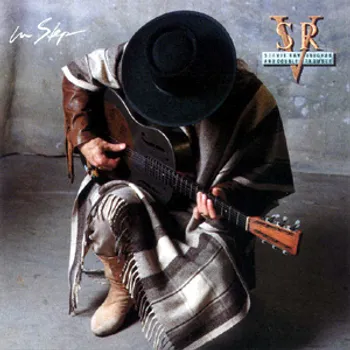
In Step (1989)
- Recorded: Late 1988 - Early 1989
- Location: Kiva Studios, Memphis, TN
- Equipment: Vaughan used various guitars, including his “Number One” Strat and a Hamiltone custom guitar
- Technique: More collaborative songwriting process with the band
- Awards: Grammy Award for Best Contemporary Blues Album; Certified Platinum by RIAA
“In Step” was Stevie Ray Vaughan’s fourth and final studio album with Double Trouble, released in 1989. It marked a triumphant return for Vaughan, who had recently become sober. The album’s title was a reference to his recovery process, and the clarity of his newfound sobriety is evident in the music.
The recording process was collaborative, with band members contributing more to the songwriting. This led to a diverse array of songs, from the hard-hitting “The House Is Rockin’” to the introspective “Tightrope,” which dealt with Vaughan’s struggles with addiction.
One of the album’s most poignant moments came during the recording of “Riviera Paradise.” The band captured the perfect take on the first try, a rarity in studio recording. As the song ended, Vaughan was moved to tears, later saying he felt like he was “in the song, not playing it.”
“In Step” showcased a more mature and refined sound, while still maintaining the fiery guitar work and blues roots that Vaughan was known for. The album was both a critical and commercial success, reaching number 33 on the Billboard 200 chart and winning a Grammy for Best Contemporary Blues Album in 1990.
Tragically, “In Step” would be the last studio album Vaughan released during his lifetime. It stands as a testament to his artistic growth and personal triumph, capturing him at a moment of clarity and creative resurgence.
Posthumous Releases
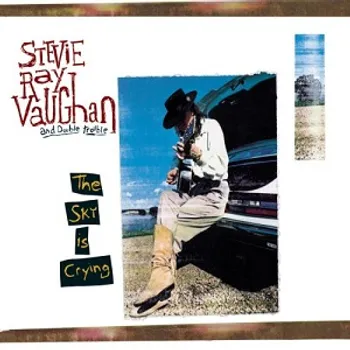
The Sky Is Crying (1991)
- Compiled from various recording sessions between 1984-1989
- Locations: Multiple studios including The Power Station, NYC and Kiva Studios, Memphis
- Awards: Certified Double Platinum by RIAA
“The Sky Is Crying” is a posthumous album released just over a year after Stevie Ray Vaughan’s tragic death. It was compiled by his brother Jimmie Vaughan from various outtakes and studio recordings made between 1984 and 1989.
This album features a collection of previously unreleased tracks, showcasing Vaughan’s versatility and growth as an artist throughout his career. It includes covers of blues classics as well as original compositions, demonstrating Vaughan’s deep connection to blues tradition and his ability to innovate within the genre.
The title track, “The Sky Is Crying,” was actually recorded during the “Soul to Soul” sessions but didn’t make the final cut for that album. Its inclusion here gave fans a chance to hear one of Vaughan’s most soulful performances.
Despite being compiled from various sources, the album feels cohesive and stands as a strong addition to Vaughan’s discography. It offers a mix of styles, from slow blues to up-tempo rockers, providing a comprehensive view of Vaughan’s musical range.
“The Sky Is Crying” was both a critical and commercial success, reaching number 10 on the Billboard 200 chart and eventually achieving double platinum status. It serves as a fitting tribute to Vaughan’s legacy, offering fans one last collection of his extraordinary guitar work and emotive performances.
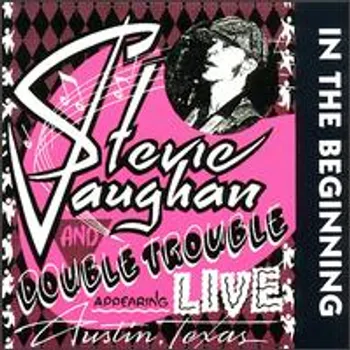
In the Beginning (1992)
- Recorded: April 1, 1980
- Location: Steamboat 1874, Austin, TX
- Equipment: Live performance setup, likely his early Fender Stratocaster
“In the Beginning” is a live album that captures Stevie Ray Vaughan before he achieved national fame, playing with an early lineup of Double Trouble in a small club in Austin. It provides a fascinating glimpse into his early style, already showcasing the virtuosity that would make him famous.
The recording was originally made for a local radio broadcast and was never intended for commercial release. Its raw, unpolished nature gives listeners a sense of the energy and excitement of Vaughan’s early performances. This unvarnished quality allows fans to experience the immediacy and intimacy of Vaughan’s club days.
The album features Vaughan on guitar and vocals, joined by Jackie Newhouse on bass and Chris Layton on drums. Despite the early stage of his career, Vaughan’s distinctive guitar work and powerful vocals are already evident, hinting at the stardom that was to come.
Released posthumously in 1992, “In the Beginning” serves as a valuable historical document, offering insight into the roots of Stevie Ray Vaughan’s music and the vibrant Austin blues scene that nurtured his talent. It stands as a testament to his early promise and the strong foundation of his music, even before he gained widespread recognition.
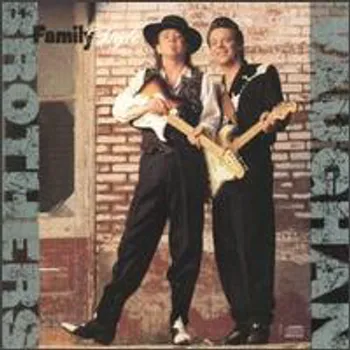
Family Style (1990)
- Recorded: Late 1989 - Early 1990
- Location: Ardent Studios, Memphis, TN
- Producer: Nile Rodgers
- Awards: Grammy Award for Best Contemporary Blues Album
“Family Style” is a unique and poignant album in Stevie Ray Vaughan’s discography, as it’s a collaboration with his older brother, Jimmie Vaughan. This project was meant to be a celebration of the brothers’ shared musical roots and a new chapter in both their careers.
The album features both Vaughan brothers on guitars and vocals, backed by a talented group of session musicians. The production by Nile Rodgers adds a polished, contemporary feel to the brothers’ blues-rock sound.
“Family Style” showcases a more diverse range of styles compared to Stevie Ray’s work with Double Trouble. The album includes elements of blues, rock, R&B, and even pop, reflecting the broad musical interests of both brothers.
What makes this album particularly special is the way it captures the musical interplay between Stevie Ray and Jimmie. Their guitar styles complement each other beautifully, with Jimmie’s more restrained approach balancing Stevie Ray’s fiery playing.
Tragically, “Family Style” was released just a month after Stevie Ray Vaughan’s untimely death in a helicopter crash. This timing imbued the album with a bittersweet quality, turning what was meant to be a new beginning into a final chapter.
Despite the sadness surrounding its release, “Family Style” was both a commercial and critical success. It won a Grammy Award for Best Contemporary Blues Album in 1991, a posthumous honor for Stevie Ray.
Live Albums
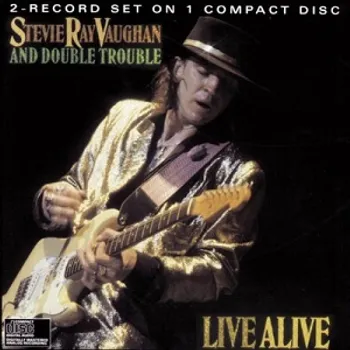
Live Alive (1986)
- Recorded: July 1985 - January 1986
- Locations: Various venues during tours
- Awards: Certified Platinum by RIAA
“Live Alive” is Stevie Ray Vaughan and Double Trouble’s first official live album, released at the height of their popularity. The album compiles performances from several concerts, capturing the raw energy and virtuosity of the band’s live shows during this pivotal period in Vaughan’s career.
Recorded shortly after the release of “Soul to Soul,” the album showcases the expanded lineup of Double Trouble, including keyboardist Reese Wynans. This addition brought new textures and dimensions to the band’s sound, allowing for more varied arrangements of their blues-rock repertoire.
The tracklist spans Vaughan’s career up to that point, featuring songs from all three of his studio albums as well as covers of blues classics. Highlights include electrifying versions of “Say What!” and “Look at Little Sister,” as well as extended jams on “Voodoo Child (Slight Return)” and “Texas Flood.”
One of the most notable aspects of “Live Alive” is the way it captures Vaughan’s incredible guitar work in a live setting. His solos are often longer and more adventurous than their studio counterparts, demonstrating his ability to improvise and feed off the energy of a live audience.
However, the album is also somewhat controversial among fans and critics. Some of the performances were reportedly overdubbed or altered in post-production, a decision that Vaughan later expressed regret over. This was partly due to his struggles with substance abuse during this period, which sometimes affected his live performances.
Despite these issues, “Live Alive” remains an important document of Vaughan’s live prowess. It showcases his ability to transform and extend his songs in concert, turning them into vehicles for extended improvisation and audience interaction.
The album was a commercial success, reaching number 20 on the Billboard 200 chart and eventually achieving double platinum status. It helped cement Vaughan’s reputation as one of the premier live acts of his era.
In retrospect, “Live Alive” stands as a snapshot of Stevie Ray Vaughan and Double Trouble at the peak of their commercial success, showcasing both the incredible highs of their live performances and hinting at the personal struggles that were occurring behind the scenes. Despite its imperfections, it remains a powerful testament to Vaughan’s live charisma and guitar virtuosity.
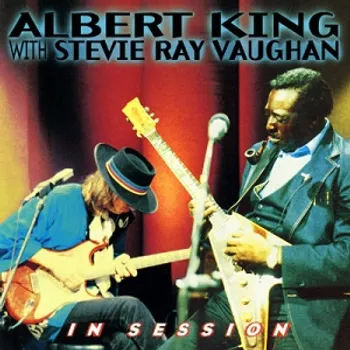
Album photo credit from Wikipedia licensed under Fair use
In Session (1999) - with Albert King
- Recorded: December 6, 1983
- Location: CHCH-TV Studios, Hamilton, Ontario, Canada
- Equipment: Both guitarists used their signature instruments - King his Flying V and Vaughan his Stratocaster
“In Session” is a unique and historic album that captures a remarkable meeting between Stevie Ray Vaughan and one of his greatest influences, blues legend Albert King. Recorded for a Canadian television program, this session documents the only known recording of these two blues giants playing together.
The album showcases the mutual respect and musical chemistry between the 39-year-old King and the 29-year-old Vaughan. At this point in his career, Vaughan had recently released his debut album “Texas Flood” and was rapidly gaining recognition, while King was already an established blues icon.
The session is notable for its relaxed, jam-session feel. Between songs, listeners can hear King and Vaughan engaging in casual conversation, sharing stories, and discussing their approaches to the blues. This banter provides fascinating insights into their relationship and the blues tradition they shared.
Musically, the album is a tour de force of electric blues. The setlist includes classics from King’s repertoire like “Born Under a Bad Sign” and “Call It Stormy Monday,” as well as shared favorites such as “Match Box Blues.” One of the highlights is their extended jam on “Blues at Sunrise,” where both guitarists trade licks and solos, demonstrating their distinctive styles and mutual admiration.
What makes this recording particularly special is the opportunity to hear Vaughan playing alongside one of his heroes. His reverence for King is evident, yet he holds his own, showcasing the skills that were rapidly making him a star in his own right. King, for his part, seems to relish playing with his young protégé, pushing Vaughan to new heights.
The album wasn’t released until 1999, nine years after Vaughan’s death and seven years after King’s passing. Its release allowed fans to experience this magical moment in blues history, hearing two generations of blues guitarists at the top of their game.
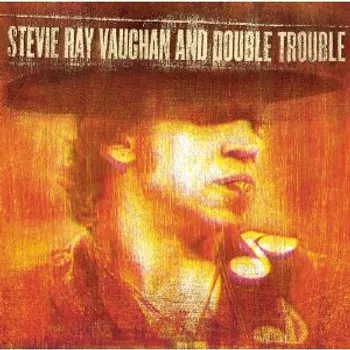
Album photo credit from Wikipedia licensed under Fair use
Live at Montreux 1982 & 1985 (2001)
- Recorded: July 17, 1982 and July 15, 1985
- Location: Montreux Jazz Festival, Switzerland
- Equipment: Vaughan’s live setup, including his famous “Number One” Stratocaster
“Live at Montreux 1982 & 1985” is a unique album that captures two pivotal performances in Stevie Ray Vaughan’s career at the prestigious Montreux Jazz Festival. This release provides a fascinating look at Vaughan’s rapid evolution as an artist over just three years.
The 1982 performance represents Vaughan’s international debut. At this point, he was virtually unknown outside of Texas, and the European audience was initially skeptical of this newcomer. The set was met with mixed reactions, including some booing from jazz purists who were unprepared for Vaughan’s high-energy blues rock. Despite the challenging reception, Vaughan and Double Trouble delivered a fierce performance that included early versions of songs that would later appear on “Texas Flood.”
Notable moments from the 1982 set include a blistering rendition of “Hide Away” and an early version of “Love Struck Baby.” The raw energy and determination in Vaughan’s playing are palpable, even in the face of the audience’s initial resistance.
The 1985 performance presents a stark contrast. By this time, Vaughan had become an international star, riding high on the success of his first three albums. The Montreux audience welcomed him as a returning hero, and the performance reflects Vaughan’s growing confidence and musical maturity.
The 1985 set showcases a more diverse range of material, including songs from “Couldn’t Stand the Weather” and “Soul to Soul.” Highlights include an extended version of “Voodoo Child (Slight Return)” and a heartfelt rendition of “Lenny.” The addition of keyboardist Reese Wynans to the band allows for a fuller sound and more varied arrangements.
What makes this album particularly special is the opportunity it provides to hear Vaughan’s growth as a performer and bandleader in the span of just three years. The contrast between the two performances is striking, from the song selection to the crowd reaction to Vaughan’s own playing and stage presence.
Released posthumously in 2001, “Live at Montreux 1982 & 1985” offers fans a chance to experience two historic performances that bookend Vaughan’s rise to international stardom. It stands as a testament to his incredible journey and the rapid evolution of his artistry, capturing both the hungry young bluesman and the confident guitar hero he became.
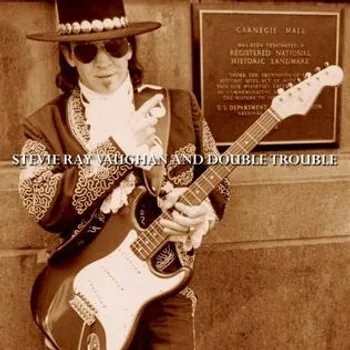
Live at Carnegie Hall (1997)
- Recorded: October 4, 1984
- Location: Carnegie Hall, New York City
- Notable: Featured an expanded band lineup for this special performance
“Live at Carnegie Hall” captures a pivotal moment in Stevie Ray Vaughan’s career. This concert, recorded on his 30th birthday, marked Vaughan’s debut at the prestigious Carnegie Hall and represented a significant milestone in his rise to stardom.
The performance featured an expanded band, moving beyond the core Double Trouble lineup. In addition to Tommy Shannon on bass and Chris Layton on drums, the ensemble included Jimmie Vaughan (Stevie’s brother) on guitar, Dr. John on piano, George Rains on drums, and the Roomful of Blues Horn Section. This expanded lineup allowed for a fuller, more dynamic sound that showcased new dimensions of Vaughan’s music.
The setlist for the concert was carefully curated to highlight both Vaughan’s blues roots and his expanding musical palette. It included classics like “Scuttle Buttin’” and “Lenny,” as well as covers of Jimi Hendrix’s “Voodoo Child (Slight Return)” and Guitar Slim’s “The Things (That) I Used to Do.”
One of the most memorable moments of the concert was the acoustic performance of “Rude Mood,” which demonstrated Vaughan’s versatility as a guitarist. The inclusion of horns and piano also allowed for more textured arrangements of songs like “Dirty Pool” and “Ain’t Gonna Give Up on Love.”
Although the concert took place in 1984, the album wasn’t released until 1997, seven years after Vaughan’s death. Its release gave fans a chance to experience this historic performance and provided a snapshot of Vaughan at a crucial point in his career, confidently stepping onto one of the world’s most renowned stages and delivering a performance that solidified his status as a blues rock icon.
The album is not just a document of a great concert, but a testament to Vaughan’s growth as an artist and his ability to rise to the occasion on one of the biggest nights of his career. “Live at Carnegie Hall” stands as one of the most significant live albums in Vaughan’s discography, offering both the raw energy of his earlier performances and hints of the musical maturity that would characterize his later work.
Compilation Albums
- Greatest Hits (1995)
- The Essential Stevie Ray Vaughan and Double Trouble (2002)
- The Real Deal: Greatest Hits Volume 2 (1999)
- Solos, Sessions & Encores (2007)
Box Sets
- SRV (2000) - A comprehensive 3-CD box set
- The Complete Epic Recordings Collection (2014) - A 12-disc set containing all of SRV’s studio and live albums
Collaborations and Guest Appearances
- David Bowie’s “Let’s Dance” album (1983)
- Lonnie Mack’s “Strike Like Lightning” album (1985)
- Various artists on the “Back to the Beach” soundtrack (1987)
Final Thoughts
Stevie Ray Vaughan’s impact on the world of blues and rock music cannot be overstated. In his tragically short career, he managed to revitalize the blues genre, inspire countless guitarists, and leave behind a legacy that continues to resonate with music lovers worldwide.
Vaughan’s journey from the clubs of Austin to international stardom is a testament to his extraordinary talent, dedication, and passion for music. His ability to channel raw emotion through his guitar playing, combined with his soulful vocals and songwriting, created a unique sound that bridged the gap between traditional blues and modern rock.
What sets Vaughan apart was not just his technical prowess, but his ability to connect with audiences on a deeply emotional level. Whether performing in small clubs or large arenas, he played with the same intensity and authenticity, always staying true to his blues roots.
His personal struggles with addiction and subsequent recovery added another layer of depth to his later work, infusing his music with hard-won wisdom and a renewed appreciation for life. This journey is reflected in the evolution of his sound across his albums, from the raw energy of “Texas Flood” to the more introspective and polished “In Step.”
Stevie Ray Vaughan’s untimely death in 1990 cut short a career that was still ascending, leaving fans to wonder what musical heights he might have reached. However, the body of work he left behind - from his studio albums to his electrifying live performances - ensures that his influence will continue to be felt for generations to come.
In the end, Stevie Ray Vaughan’s legacy is not just about his phenomenal guitar skills or his chart-topping albums. It’s about the passion, honesty, and soul he brought to every note he played. He reminded us of the power of the blues to express the full range of human emotion, and in doing so, he secured his place as one of the greatest guitarists and musical innovators of all time.
Back